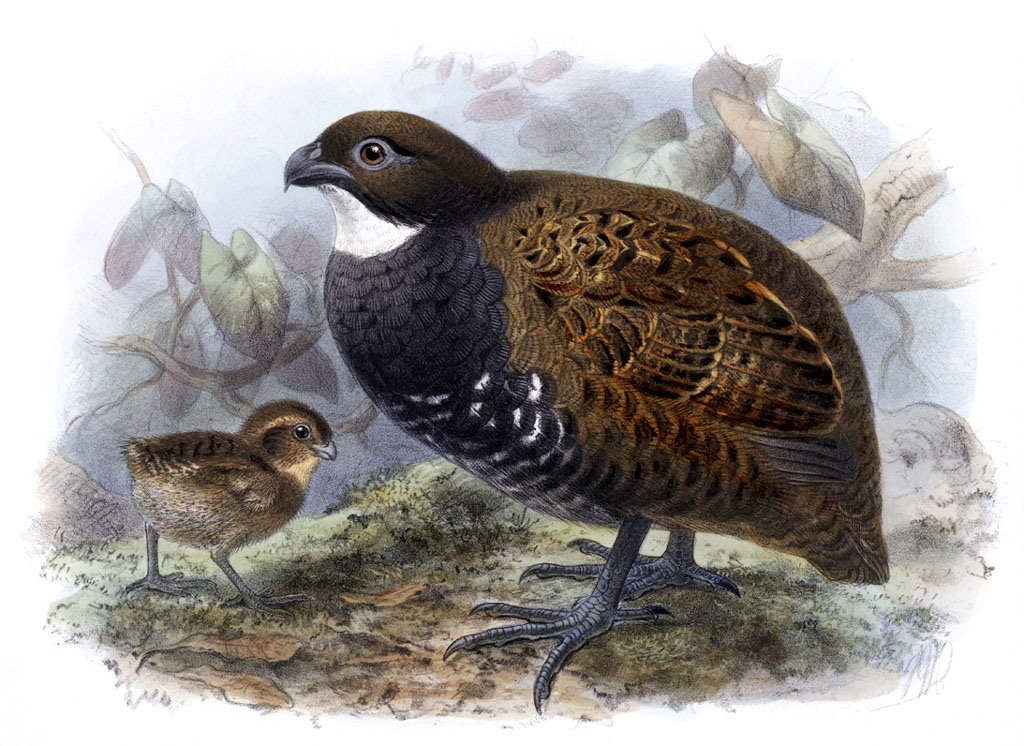- Wood-quail
Taxobox
name = Wood-quail

image_width = 250px
image_caption = "Odontophorus leucolaemus"
regnum =Animal ia
phylum = Chordata
classis = Aves
ordo =Galliformes
familia = Odontophoridae
genus = "Odontophorus"
genus_authority = Vieillot, 1816
subdivision_ranks = species
subdivision = "see species list"The Wood-quails are
bird s in the genus "Odontophorus" of theNew World quail family, which occur as resident breeding species in New World tropical cloud- and rainforests. The core range of the genus is centred on the lowlands and foothills of the northernAndes ofColombia and the mountain ranges ofCentral America ; however, some species occur elsewhere in tropicalSouth America .These are species of dense understory thickets or
bamboo s, and as a consequence are amongst the most difficult Galliform birds to study or even observe. The best chance of seeing wood-quail is at dawn or dusk, when they may feed at the side of a road or on a forest track in family groups of up to 12 birds.Wood-quails are 22-30 cm long dumpy, short-tailed, stout-billed partridge-like birds with a bushy crest. The upperparts are dark brown, and the underparts are lighter brown, grey or rufous. Some species have striking black and white throat or facial markings. The sexes are similar, but the female often has a duller-coloured crest. The advertising calls are loud and distinctive duets consisting of repeated phrases, and are often the only indication that wood-quail are present.
For most wood-quail, information has mainly come from specimens, and breeding behaviour and habits are little known. The majority of species, including the relatively widespread
Spotted Wood-Quail have never had the nest described.Those species for which the feeding habits are known forage on the ground, scratching at the soil for seeds, fallen fruit and insects. Wood-quail are typically shy and wary; they will normally make good their escape on foot, but if startled will explode into a short fast flight into dense cover.
All wood-quail species have been adversely affected by hunting and, in particular, rampant deforestation. Several species with restricted ranges are now vulnerable, and some now have populations of less than 1000 birds.
pecies list
*
Marbled Wood Quail , "Odontophorus gujanensis"
*Spot-winged Wood Quail , "Odontophorus capueira"
*Black-eared Wood Quail , "Odontophorus melanotis"
*Rufous-fronted Wood Quail , "Odontophorus erythrops"
*Black-fronted Wood Quail , "Odontophorus atrifrons"
*Chestnut Wood Quail , "Odontophorus hyperythrus"
*Dark-backed Wood Quail , "Odontophorus melanonotus"
*Rufous-breasted Wood Quail , "Odontophorus speciosus"
*Tacarcuna Wood Quail , "Odontophorus dialeucos"
*Gorgeted Wood Quail , "Odontophorus strophium" [http://news.bbc.co.uk/1/shared/spl/hi/pop_ups/05/sci_nat_last_chance_to_see000/html/3.stm]
*Venezuelan Wood Quail , "Odontophorus columbianus"
*Black-breasted Wood Quail , "Odontophorus leucolaemus"
*Stripe-faced Wood Quail , "Odontophorus balliviani"
*Starred Wood Quail , "Odontophorus stellatus"
*Spotted Wood Quail , "Odontophorus guttatus"References
* Hilty, " Birds of Venezuela", ISBN 0-7136-6418-5
* Madge and McGowan,"Pheasants, Partridges and Grouse" ISBN 0-7136-3966-0
* Stiles and Skutch, "A guide to the birds of Costa Rica" ISBN 0-8014-9600-4
Wikimedia Foundation. 2010.
